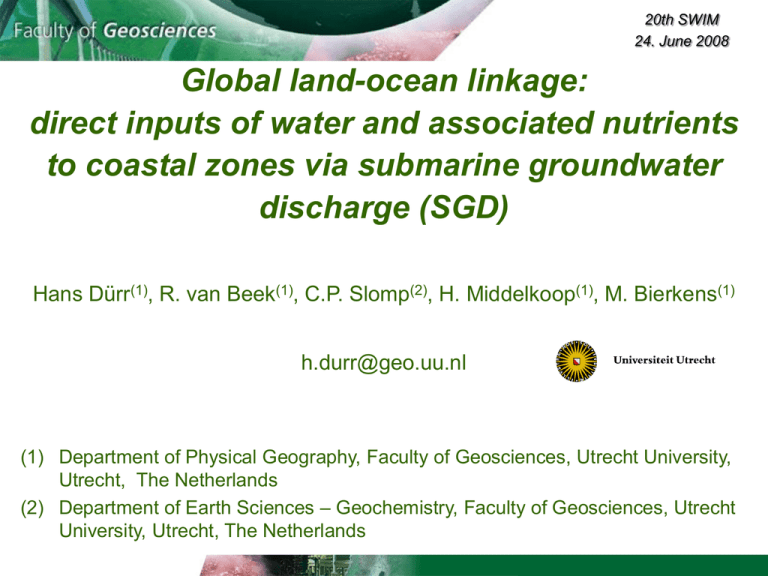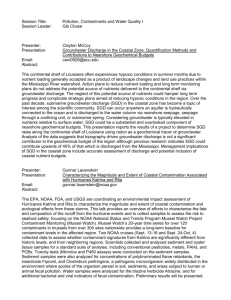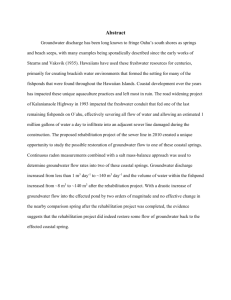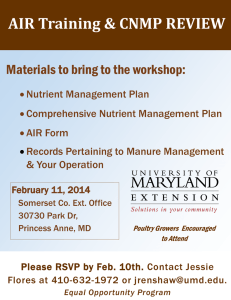Global land-ocean linkage: direct inputs of water and associated nutrients
advertisement

20th SWIM 24. June 2008 Global land-ocean linkage: direct inputs of water and associated nutrients to coastal zones via submarine groundwater discharge (SGD) Hans Dürr(1), R. van Beek(1), C.P. Slomp(2), H. Middelkoop(1), M. Bierkens(1) h.durr@geo.uu.nl (1) Department of Physical Geography, Faculty of Geosciences, Utrecht University, Utrecht, The Netherlands (2) Department of Earth Sciences – Geochemistry, Faculty of Geosciences, Utrecht University, Utrecht, The Netherlands Effects of nutrient enrichment (eutrophication) of coastal waters more algal blooms red tide (harmful algal bloom) foam Rationale • Higher nutrient inputs (N, P) from rivers to coastal waters + estuaries, inverse trend (decrease) due to damming for Si • Global nutrient fluxes at the land-ocean interface: Terrestrial controls, impact on coastal waters and response to global change. Spatially explicit, multiple nutrient forms (dissolved / particulate, inorganic / organic) • Box modelling (Slomp & van Cappellen 2004) has shown potential impact on coastal zone of nutrient SGD at global scale • Typically: Groundwater N and P flux = total SGD flux x nutrient concentration, but decisive for net balance: fresh GW flux x nutrient concentration ( local scale effects of subterranean estuary) • Submarine Groundwater Discharge (SGD) of nutrients: spatially explicit not yet estimated at global scale, comparison to river inputs (water discharge globally ~5-10% of river discharge)? Proximal coastal ocean N:P ~ 14:1 river input eolian input N denitrification groundwater input Phytoplankton (mostly N-limited) Redfield N:P = 16:1 N:P mostly >>> 16 recycling export to continental shelf burial • Fresh SGD: mostly N, less P (elevated velocity seeps in shallow, oxic systems: P removal, conservative behaviour of NO3), could drive systems to P-lim. • Only in cases when both GW and sediment are anoxic and upon saltwater intrusion: N/P ratio of SGD < Redfield • Deep GW supply mostly minor & not contaminated QChannel PREC Epot PREC Epot Canopy Eact QDR T Snow cover Store 1 P QSf Each cell: - Conceptual model partly River icebased on the HBV model RS Climate variables are Tw from theTERA40 data set A - Transfer / Routing of runoff toSnow/Rain the drainage network RS LH(Epot) TA Store 2 For baseflow here: Q - Not fully calibrated yet Snow/Rain - Energy balance + lakes will be considered in later stages - Monthly values annual means QBf P Store 3 0,5° grid QChannel Courtesy R. van Beek Model structure Concept of groundwater flow • Kraaijenhof-Van de Leur (1958) – Boussinesq – Dupuit assumptions to calculate the reservoir coefficient kr 2 kD kr 4 fB2 where: k is the hydraulic conductivity (L·t-1 e.g., m/day), D is the aquifer thickness (L, 50m assumed), f is the drainable porosity (obtained from lithology + some Holdridge climate data) (dimensionless, 0-1) and B is the aquifer width (L). Using various global data sets Courtesy R. van Beek Result: Residence time of Groundwater Long residence times: - Highly weathered soils - Tropics Model performance (no full calibration yet): - Good in most temperate and tropical regions - Weaker in Arctic + semi-arid regions: no evaporation from surface waters yet, snowmelt driven by mean monthly temp. Next step – full calibration on low flow conditions Courtesy R. van Beek Local groundwater discharge High in: Some tropical regions, esp. SE-Asia / Indonesia; W Canada, Florida; Ex.: Patos Lagoon Low: Arctic, but % contribution to total flow is high Courtesy R. van Beek Next steps, including nutrients • Coastal water divide where baseflow = SGD?? • Human GW extraction? • Salt-water intrusion sites (low-lying areas)?! • Range of GW nutrient concentrations for DIN ~NO3 • Test nutrient attenuation scenarios, e.g., based on half-life approaches • Coupling to information from landuse and population Coastal ribbon definition for SGD: distance to water divide at coast Problem : last gauging station what is a stream ??? every catchment basin that has a cumulated upstream area > xx km2 subgrid variability 0,5° grid cell testing possible Groundwater abstraction Water extraction: - country based GW abstraction from IGRAC / TNO - linked to total water use and population numbers from Vörösmarty et al. Courtesy Rens van Beek (NO3) Range of GW nutrient concentrations in different landuse settings Agricultural Urban Misc. Undevel. land USGS Summary data High Groundwater Nitrate sites Data from IGRAC / TNO Potential hotspots with potentially elevated N input Caution: - Very local phenomena not detected - Total Groundwater flow in coastal cells, not SGD - GW abstraction not considered - Saltwater intrusion not considered - Effect of residence time in GW on nutrient concentrations Some study sites for SGD including nutrients Rivers Similarities in regions, local differences Groundwater DIN-NEWS empirical model: Dumont et al. 2005 Conclusions: first steps towards • Spatially explicit estimates of SGD at global scale, using baseflow estimates from new global hydrological model • Potential hot spots of freshwater nutrient SGD – SE Asia (esp. Indonesia) + Central America: hot spots for both river and GW fluxes (high baseflow, high runoff and high levels of human activity) – exact locations and time scales may be different • Field studies needed in high ‘risk’ areas, e.g. (sub-)tropical areas of Africa, S America and SE Asia – some studies now underway • Examples have been shown to include amendments such as GW abstraction, GW quality data, landuse + population data As source of ‘new’ nutrients, especially N (less P), freshwater SGD is potentially important for coastal nutrient cycling (N-limitation of most coastal waters) at global scale (strong response to human impact) Thank you ! Questions ? Hand-outs available, ask anytime or email: h.durr@geo.uu.nl Salt-water intrusion: CaHCO3 freshwater is replaced by NaCl and SO42- rich sea water Na+ Ca2+ Ca2+ Ca2+ Na+ Na+ Ca2+ Na+ -Na2+ replaces Ca2+, NH4+ -Cl- or SO42- replaces PO4 - Increased degradation of organic matter (Nyvang, 2003) - Increased sulfate reduction & reduction of Fe-oxides by S2NH4 and PO4 release to the groundwater





